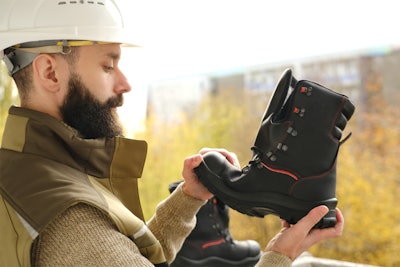
The goal for construction work boots is that they help with safety, comfort and performance on the job. Choosing the correct width for a construction boot is just as important as the length.
Wearing ill-fitting boots can result in painful blister and calluses; ingrown toenails, corn and bunions; numbness and nerve compression; chronic foot conditions; ankle sprain and foot fatigue.
While it is common to find information about a boot size regarding its length – such as size 9 – it is not so common to see its width listed. Some people have feet that are more wide or narrow; others can have high arches or other types of foot conditions.
Boot Width Options
Widths are identified is two different ways, depending on the boot brand.
It may be noted as N for narrow, M for medium or standard, W for wide and XW for or EW for extra wide on many boot brands, while some legacy brands use the more precise classic size standard. That is important to keep in mind as different brands may have slightly different sizing standards.
Width options also are identified as A, B, C, D, E, EE and EEE. AAA is the most narrow width and EEE is the widest. The difference between size D and EE, for example, is 3/8″ or 1 cm at the widest part of the boot.
D width – also known as ‘medium’ – is standard and a common measurement. This story provides charts for both women and men on determining correct boot length.
Which One is Right for you?
Determining the correct width for a construction boot starts by measuring the foot. The gold standard for doing so is the Brannock device, commonly seen in shoe stores where employees often help to measure the feet.
The foot is placed onto the Brannock measuring device to determine the length and width of a foot in order to make the correct footwear selection. The devices are available online for purchase. Absent access to a Brannock device, try measuring the widest part of the foot in inches by placing the foot on a piece of paper, tracing the outline and measuring the distance between the widest parts, usually around the ball area.
Stand up while taking the measurements. This will entail the assistance of someone to draw the measurement around the foot. Generally, in choosing boot sizes, it is advised to start with a half size down from other footwear such as athletic shoes that are worn, especially those with narrow feet. Some people may even try a whole size down. Those with narrow feet may need to try a half-size smaller.
Measure both feet as one foot may not be the same size as the other. Choose the size of the bigger foot. For precision, measure on the inner edge of the foot sketch.
Tips for Measuring Boot Width
Feet can swell for several reasons; it is best to measure them in the morning. But those who are prone to swollen feet should consult a medical professional on how best to choose a boot width in light of these issues.
Standing up during measurements helps ensure the best accuracy – to obtain the most precise accuracy, take multiple measurements.
It is best to try on boots with the socks that will be worn with them while on the jobsite. When trying on boots, there should be enough room in the toe area – about a half inch – to comfortably wiggle the toes. Look for a fit that is secure without slipping and snug, but not overly constricting. Try a wider width if the sides of the feet feel pinched or show signs of bulging.
When trying on boots, walk around in them to determine how they feel while the foot is in motion. Boots used for construction work must meet safety standards, such as slip resistance, toe protection and ankle support. Given that, keep in mind that a steel-toed boot may fit differently than other construction boot types.
When in doubt, consult a podiatrist on the best boot selection based on particular foot factors as to avoid any foot problems by making the wrong selection.
Breaking in boots while wearing them for short periods of time around the house or on the job helps ensure maximum comfort on the worksite.
















